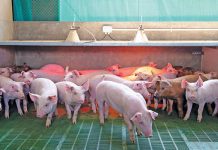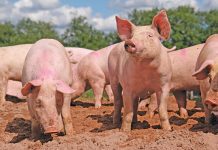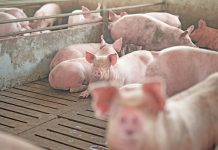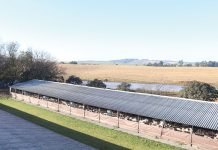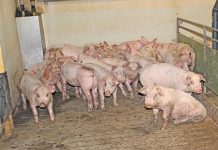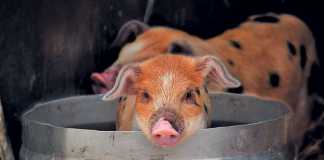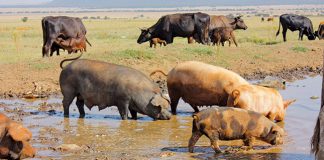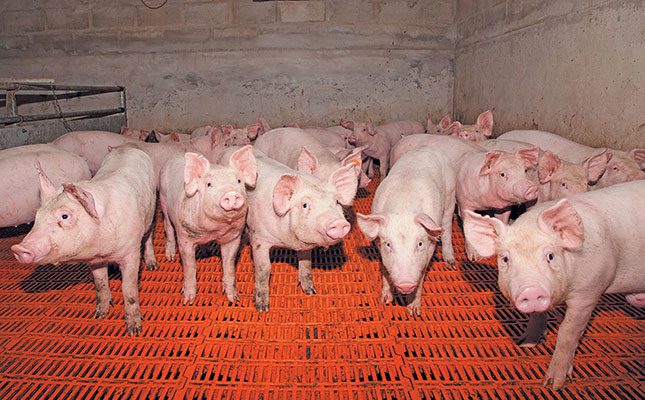
It therefore stands to reason that these more congested environments where pigs are raised are predisposed to the proliferation of diseases such as diarrhoea and respiratory conditions such as pneumonia.
This is a particular risk if the farmer isn’t proactive in respect of maintaining good housing hygiene and enforcing of biosecurity protocols.
READ Managing your pigs’ health
Management regimens such as the cleaning of sties, disinfecting of living areas and interior wall surfaces from time to time, and the regular removal of faeces are vital if a producer wishes to prevent the creation of an environment where dangerous organisms can flourish.
Deworming programmes, good nutrition and clean water provision, proper bedding (such as course sawdust), shelter, and good ventilation all form integral components of functional pig breeding.
It is also prudent to install human foot baths that contain disinfectants at the entrance to the pigs’ housing complex, and farmers can even consider spraying the undercarriage and tyres of vehicles entering the biosecurity zone to reduce the risk of devastating diseases such as African swine fever.
Producers should intramuscularly inject piglets with an iron supplement in the thick part of the muscle behind the ear on the third day of life as piglets are prone to anaemia.
An iron supplement such as Dexiron 200 can be used for this.
Pigs can also be injected with an antiparasitic such as Dectomax or Ecomectin if flaky skin or signs of worms are observed in faeces. Even if a farmer does not notice such health issues, injecting with an antiparasitic every four to six months can only be of benefit.
Another important dimension of functional pig farming is the administering of vaccines, which are primarily aimed at, but not limited to, preventing common illnesses such as diarrhoea and pneumonia.
These illnesses are particularly troublesome when infecting piglets or young pigs. Female pigs are also prone to contracting illnesses that lead to reproductive failure, and this is very costly to the farmer.
The importance of vaccination
Vaccinations play an important role in a good and prosperous farming operation. Note that, in addition to the products or brands listed below, there may be a host of other products that perform similar roles in preventing the contracting and spread of prevalent illnesses.
READ Animal welfare: Raising stress-free pigs
There may also be other illnesses that can be counteracted via using vaccines that are not mentioned here, and it will benefit a farmer to become knowledgeable in respect of which pig diseases are prevalent in his/her area.
It is also wise to consider options that may suit a farmer’s particular needs and to keep abreast of new vaccines and vaccination regimens that may emerge.
Before administering rarely used vaccines, ask about important possible side effects that may affect young or pregnant animals, and so forth.
It is important to read vaccine information leaflets properly and to administer vaccinations exactly as per manufacturers’ instructions.
Different vaccinations for different classes of pigs
Piglets: At one week of age, inject the piglet intramuscularly in the muscle behind the ear with Respisure, and at three weeks of age, inject it with Respisure again and also with Fostera PCV MetaStim.
Administer each injection on a different side of the neck. Always use sterile syringes and needles and use a short, thinner gauge needle when injecting piglets.
Rather use boiling water instead of disinfectants to sterilise already used injection equipment, because disinfectants can affect the efficacy of vaccines.
Gilts (young sows being mated for first time): Five weeks before breeding/mating, inject the animal behind the ear into the muscle with FarrowSureGOLD B, and then again two weeks before mating.
Then, five weeks before giving birth, inject it with LitterGuard LT-C, and inject again with this vaccine two weeks before farrowing (giving birth). Remember that pigs are pregnant for about three months, three weeks and three days, but a range of between 111 and 120 days is not uncommon.
Keeping record of vaccinations and deworming dates, mating and farrowing dates, piglet birth dates and so forth is essential for maintaining a feasible vaccination programme. Keep these dates on a calendar and hang the records where they can easily be seen.
Sows: Two weeks before breeding/mating, inject the animal behind the ear with FarrowSureGOLD B, and two weeks before farrowing, with LitterGuard LT-C.
Gilts and sows will need syringes and needles slightly longer and thicker than those used on piglets; obtain advice on this at the farmer supply store.
Boars: Improvac is used for boars above 10 weeks of age, and a second vaccination can be administered four to five weeks before slaughter.
This product has benefits in that it improves fat marbling and allows for a better quality of fat on the carcass. It also assists in reducing carcass lesions that could occur due to aggressive mating behaviour.
|
Vaccinate your pigs against these diseases – SAPPO |
Precautions
The above mentioned vaccines are administered intramuscularly (in the neck muscle behind the ear) at a rate of 2ml per animal.
Adult pigs will usually require a longer needle than piglets because there may be much fat in the neck area that needs to be penetrated before the muscle is reached.
Obtain advice in respect of what syringes and needles are needed for what class of pigs. Always use sterile equipment and ensure that hands are properly sanitised with soap before and after administering vaccines or any other medication.
Utmost caution should be taken when vaccinating pigs that can show aggression toward handlers. Ensure that the pigs are cautiously handled and immobilised before administering any form of injection.
Accidental needle injuries to humans are not uncommon if pigs are restless and jumping about when being injected. Some pigs, particularly boars and older suckling sows, may show extremely aggressive behaviour towards humans while being handled.
A bite by a pig should immediately be disinfected and medical attention should be sought.
While vaccines greatly limit the possibility of pigs contracting diseases, other practices such as good sanitation, general piggery hygiene, facility biosecurity measures, functional housing facilities, and good nutrition at all times play a vital role in maintaining a functional farming operation.
Remember that vaccines are usually heat-sensitive and should thus be kept strapped to ice and in a cooler bag or box, out of direct sunlight, when transporting them. Vaccines that have undergone elevated temperature variances or have expired may be ineffective and should not be used.
Article Source: Swine vaccination programme by Zoetis


